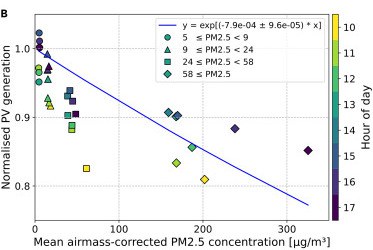Fighting forest fires with solar systems
Sydney, Erlangen/Nuremberg, 08.02.2024 - Solar systems are widespread and sensitive to smoke. A recent study shows that solar systems can therefore make an important contribution to the detection and monitoring of forest fires.
More than 240,000 square kilometers of destroyed bush and forest land across Australia were the result of the devastating forest fires in 2019 - 2020. The scale of the natural disaster did not stop at Australia's borders: over 700 million tons of CO2 were released into the atmosphere. In a recent study, a team of researchers from the School of Photovoltaic and Renewable Energy Engineering (UNSW) in Australia and the Helmholtz Institute for Renewable Energy (HI ERN), a branch of Forschungszentrum Jülich, investigated how forest fires affect electricity generation from photovoltaic systems and to what extent solar systems can be used to detect and monitor forest fires in the future.
Scientific achievement
Scientists Ethan Ford and Prof. Bram Hoex (School of Photovoltaic and Renewable Energy Engineering, Australia) and HI ERN physicist Dr. Ian Marius Peters analyzed data from 160 private solar installations in New South Wales (NSW). The forest fires here led to extreme haze, which significantly impaired the performance of the solar systems. The researchers found that the concentration of particulate matter (PM2.5) reduced energy production by an average of 13 ± 2 % per 100 μg/m3 PM2.5. This resulted in an estimated energy loss of 175 ± 35 GWh and a financial loss of up to 19 ± 4 million USD. The results of the study were recently published in iScience.

Social and scientific relevance
Climate change is leading to increasingly dry conditions and making vegetation more susceptible to fires, and not just in Australia. In order to deal resiliently with the increasing number of forest fires, it is important to detect and monitor fire sources at an early stage. As solar systems are sensitive to smoke and are widespread, they could be used in the future to support the detection and monitoring of forest fires. These findings are important for the planning and operation of solar systems in areas with an increased risk of forest fires. With the findings of their study, the three scientists are making an important contribution to minimizing the impact of such natural disasters in the future.
Original publication
Ethan Ford, Ian Marius Peters, Bram Hoex
Quantifying the impact of wildfire smoke on solar photovoltaic generation in Australia
iScience, Volume 27, Issue 2, 2024, https://doi.org/10.1016/j.isci.2023.108611.
Contact
Dr. Ian Marius Peters
Gruppenleiter "Hochdurchsatz Charakterisierung und Modellierung für die PV"
Room 2.3



